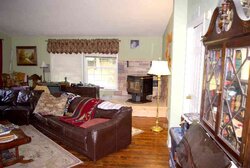For all you DIY'ers out there please take note on a few things for direct-vent applications. For those who do not know, Direct vent is basically installing out through an exterior wall, with or without an outside air connection.
- If you are a homeowner doing the install yourself, put a call in to your local building department or other authority and ask them what paperwork you need to fill out and what they will be looking for when they inspect it.
- Never start an installation until you have all of the venting, hearth pad and the stove onsite.
- READ YOUR INSTALLATION MANUAL FRONT TO BACK A FEW TIMES OVER A FEW DAYS. If you know what stove you are going to get, go online, print out the manual and read it while your saving your pennies or waiting for delivery of your purchase.
- Choose your hearth placement carefully. Take a few pictures from inside and outside, print em up and draw it out. Make a sketch or two of how you envision the installation.
- Interior things to consider: A) The hearth pad or other non-combustible material under the hearth must extend beyond the left, right, rear and front side of the stove per the UL listing on the stove; B) Combustible materials such as wall board, trim, furniture, drape etc.. must not be closer to the stove's left, right and rear side than the UL listing's recommended minimum distance and there should be at least 3 feet distance horizontally from the front.
- Exterior things to consider: A) Your venting termination needs to be at least 4 feet from any opening door or window unless the installation manual will allow for a reduction with the use of an outside air kit. Not all do. Some require the kit and still give no reduction.
- DO NOT INSTALL IN AN ALCOVE OR ZERO CLEARANCE APPLICATION UNLESS THE UL LISTING PERMITS IT. ALL STOVE VARY AND SOME ARE NOT LISTED AS SUCH.
- When positioning you stove inside the house for a direct out application (no interior rise), do a dry run (set the stove on the hearth) at the minimum distance allowed by the manufacturer. Look good? Now, can you get behind the machine to make the connections to the vent? No? Well then you may want to move it off the wall a touch. Personally, I like to have my units at least 9" from the wall so I can get behind the stove with tools if needed. Most thimbles (wall pass through fire stops) will require a circle or square to be cut that is 7-10 inches wide. If you have a stove with a very low take-off, make sure it clears any low obstructions such as baseboards or baseboard heaters. Additionally, make sure your hole will clear hidden obstacles too, such as studs or wiring.
- Now that you have found where you want the stove, attach a short vent pipe to the stove if your are going straight out or fabricate ALL of the interior pipes if you are going up and out and then back the stove up until your pipes meet the wall flush. Circle the pipe with a pencil on the wall, this is where your vent is going out. Use an arbor drill level to make your inside and outside center hole.
- Get busy and fashion out the hole that your thimble requires. A slightly bigger hole than you need (1/4") will make your life easier. When the hole is cut and clean, attach your thimble through the wall. Place a length of pipe through the thimble and then admire your work.
- Clean up inside and then go outside to make all of the required vent connections.
- When your outside venting is complete, head back inside and connect the stove. Before you seal, or affix the interior venting, make sure your hearth, stove and vent are aligned properly, then seal the connections.
- Add pellets. Clean the stove. Remove fingerprints from trim metals and glass. Remove and combustible material from the fire box such as literature,Plug her in and start her up.




